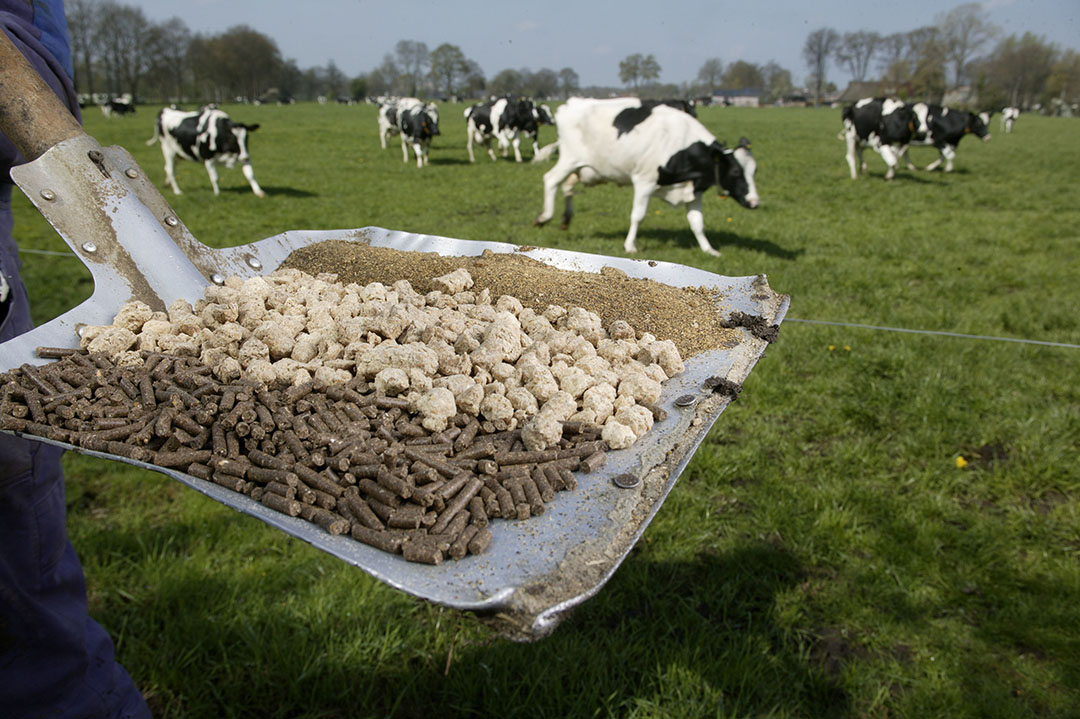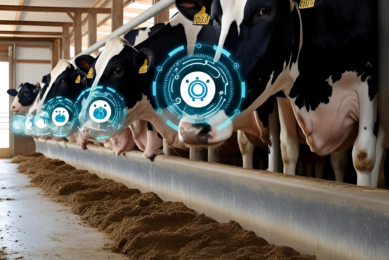Feed Compass aims for future-fit feed

The Feed Compass project is exploring the impacts of the animal feed system – and the strategies to make it more sustainable. We talked to Dr Lesley Mitchell from Forum for the Future about how the project is bringing actors together and what the next steps are.
Large food companies, including retailers and those active in the foodservice are increasingly looking for ways to make the agri-food system more sustainable. And these large corporate firms are not only looking at the way that animals are raised. They also have an increased interest in what the animals eat, hence how sustainable the feed ingredients really are and which changes can be made here. And by looking at the animal diets, sustainability gains can be made that have a significant and long term effect on parameters such as soil depletion, water use and greenhouse gases amongst others. So it is animal feed that Forum for the Future has gotten its teeth into lately.
This international non-profit organisation specialises in addressing critical global challenges by catalysing change in key systems, from food to apparel, energy to shipping. They do this by convening transformational collaborations to drive change, by partnering with organisations to help them lead by example, and by building a global community of pioneers and change makers. Dr Lesley Mitchell is Forum for the Future’s Associate Director for Sustainable Nutrition and leads Forum’s global work on food, with an expert team covering innovative topics including the future of protein, sustainable animal feed and regenerative agriculture.
Costs and impacts of animal feed
In 2017, Forum for the Future started the Feed Compass project. With Feed Compass, Dr Mitchell and her team are building a platform that looks through the lens of all the costs and impacts of animal feed – looking at ways to bring together major actors in the feed industry and to create a pre-competitive environment for businesses to take steps forward in making feed more sustainable. Animal feed is one of 6 critical action areas chosen by The Protein Challenge 2040 group – a global cross-industry coalition which sets out to explore how we feed 9 billion people enough protein in a way that is affordable, healthy and good for the environment. “We not only aim to produce sufficient and quality food, but we also want the food to come from systems that are climate resilient, environmentally, socially and economically viable. Greater transparency about the sustainability of feed ingredients helps build trust with consumers. Progressive companies that act on feed will be better positioned to create this trust. This can be done by improving current practice or by creating new innovative solutions,” Dr Mitchell explains.
The project team therefore developed the Feed Compass principles, designed to provide an easy-to-communicate, top-line method of evaluating feed sustainability and guiding decision making. These are:
- Restorative land use and biodiversity practices
- Minimising pollution
- Minimising freshwater consumption
- Minimising greenhouse gas emissions
- Minimising fish stock depletion
- Promoting animal health and nutrition
- Taking a ‘circular’ approach
- Supporting human rights and welfare
- Being financially viable.

Animal feed ‘a hidden issue’
Being active for only 2 years now, the Feed Compass project has already made some big steps. “When we started in 2017, animal feed was a hidden issue amongst large agri-food companies. We noticed that large corporates were active in making their business more sustainable, but that was often limited to topics such as reduction of plastics or energy use. Animal feed was not on the radar for many agri-food companies. 2 years ago, we therefore started with producing the ‘feed behind our food’ report, which formed the foundation for the project. Then we organised workshops, went to several feed conferences and raised the profile of the issue. Since then we have engaged with feed innovators, producers and food retailers to work to identify challenges and opportunities to scale and we have built a collaboration between a number of European based actors in the feed sector such as Evonik, but also parties like Ahold Delhaize and Calysta. Feed Compass aims to find better ways of feeding farmed animals and fish that reduces environmental impact on land and sea, releases land for cultivation of other foods and frees up high-quality plant protein for human consumption,” Mitchell explains.
But why the sudden focus on animal feed?
Mr Mitchell: “We believe that animal feed has been the hidden part of the sustainability puzzle and significant changes can be made by looking at feed ingredients and their effect on the total agri-food chain. Within agriculture, animal feed is a defining issue across the food sector. What we choose to feed livestock matters because it relates to how we manage half of the agricultural land on the planet. In our oceans, a large volume of wild catch is transformed into fish meal for use in animal feed. At the same time, the feed chain has always been typically focused on animal nutrition, health, welfare and feed efficiency. Efficiency gains are a form of making food production more sustainable, but we are missing out on the long term costs and effects here. Think of soil depletion. If we continue like this, how many harvests can we still get from these soils? Within Feed Compass we therefore want to take a more robust and holistic evaluation to provide insights and identify areas to focus, guide decision making and enable top-line comparison between different feed ingredients. We want to help companies choose for future-fit animal feed that suits their business best,” says Dr Mitchell.
Using impact tools
Luckily, many companies are already making progress towards ‘future-fit’ animal feed. A growing number are conscious of supply chain risks, and focus on addressing issues such as deforestation through certification or other tools. McDonald’s for example has committed itself to ensure no soy from deforested land by 2020. Others are investing in new, innovative feed alternatives that require less land, are more water-efficient and have a smaller greenhouse gas emissions (GHG) footprint – in particular by sourcing alternative proteins such as insects, algae and seaweed. “But more knowledge on the real (long term) impacts of feed and at the same time, more collaboration, is needed,” Dr Mitchell says. According to her, there is no method of comparing how sustainable different types of feed are, across environmental, economic and social (the more long-term effects so to say). In other words, can we measure what these long-term effects are of using certain feed crops on soil depletion in the future for instance? The Feed Compass team is therefore developing an easy-to-use framework that will help companies to compare different types of feed and guide purchasing decisions. Dr Mitchell: “We’ve partnered with the University of Minnesota in the US to identify metrics and databases to underpin sustainability evaluation of feedstocks. As we further develop the Feed Compass Framework, we are testing its use in partnership with major companies and their supply chains.” Our ambition is that the Feed Compass tool will support the food industry in ensuring animals are fed sustainably and help to future-proof our food system in the long term.

Dr Mitchell notes that Feed Compass looks to tools such as LEAP and GFLI. LEAP (Livestock Environmental Assessment and Performance) is a multi-stakeholder initiative led by the UN Food and Agriculture Organisation that has developed guidelines for measurement of the environmental impact of animal feed. The Global Feed LCA Institute (GFLI) is an important industry initiative that aims to develop a free and publicly available feed LCA database and tool, primarily for feed companies. “These tools help in the decision making and enable understanding of the sustainability parameters better and at the same time look beyond economics and productivity.” So, what about soy for example, a major ingredient in animal diets? Dr Mitchell: “The big challenge with soy is that in aquaculture we see a shift from fish meal based diets to more vegetable protein diets. Often, fish meal is then replaced with soy, hence increasing the demand for soy on the market. In this case, the potential we see is to grow the volume of sustainable soy instead of advocating just a ban on using soy in livestock and fish diets. Almost 80% of soy produced worldwide is used as livestock feed, with much of it being cultivated in Latin America, placing its rainforests and other high value landscapes at risk. Of the 256 million tonnes of soy used in animal feed per year, only around 2.2 million tonnes is certified sustainable soy. So there is huge potential here to grow the certified soy volume. But we also look at strengthening the sustainable soy standards and aim for a fair sharing of the costs of sustainable soy production across the value chain. We also welcome initiatives such as the EU protein plan to grow protein crops such as soy more locally.”
Making better sustainable decisions
“Animal protein consumption is growing rapidly in some areas in the world such as Asia and we want to enable a future for protein that ensures sustainable healthy diets for everyone. Our project works across the food system to enable people to find ways that are right for their business and create a pre-competitive collaboration platform,” says Dr Mitchell. And this is all about changing the mindset of the agri-food companies. “Business as usual is not going to meet the urgency of the changes we need to make when it comes to making the agri-food chain more sustainable and organisations acting alone are unable to drive the change that’s needed across the feed system. We need to understand as a food sector how to implement frameworks regarding sustainability that actually work. The innovation regarding sustainable feed has to come from the feed industry itself, we want to accelerate the momentum across the animal feed system to act on it,” Dr Mitchell concludes.











